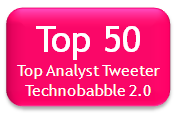Following my post last week on the need for additional filters in enterprise microblogging tools and activity streams, I participated in an interesting Twitter conversation on the subject of microblogging and complexity. The spontaneous conversation began when Greg Lowe, a well-respected Enterprise 2.0 evangelist at Alcatel-Lucent, asked:
“Can stand alone micro-blogging solutions survive when platform plays introduce the feature?”
I immediately replied:
“Yes, if they innovate faster”
Greg shot back:
“is microblogging autonomy about innovation, or simple elegance? More features usually leads to lower usability?”
And, later, he asked a complementary question:
“is there a risk of Microblogging becoming “too complicated”?”
Is Greg on to something here? Do more features usually lead to lower usability? Will functional innovation be the downfall of stand-alone microblogging solutions, or will it help them stay ahead of platform vendors as they incorporate microblogging into their offerings?
One of the commonly heard complaints about software in general, and enterprise software in particular, is that it is too complicated. There are too many features and functions, and how to make use of them is not intuitive. On the other hand, usability is a hallmark of Web 2.0 software, and, if we make it too complex, it is likely that some people will abandon it in favor of simpler tools, whatever those may be.
But that dichotomy does not tell the entire story. Based on anecdotal evidence (there is no published quantitative research available), early adopters of Web 2.0 software in the enterprise appear to value simplicity in software they use. However, as a colleague, Thomas Vander Wal, pointed out to me yesterday, that may not be true for later, mainstream adopters. Ease-of-use may be desirable in microblogging (or any other) software, but having adequate features to enable effective, efficient usage is also necessary to achieve significant adoption. Later adopters need to see that a tool can help them in a significant way before they will begin to use it; marginal utility does not sway them, even if the tool is highly usable.
Simple may not be sustainable. As I wrote last week in this post, as enterprise use of microblogging and activity streams has increased and matured, so has the need for filters. Individuals, workgroups, and communities want to direct micro-messages to specific recipients, and they need to filter their activity streams to increase their ability to make sense out of the raging river of incoming information. Those needs will only increase as more workers microblog and more information sources are integrated into activity streams.
In the public microblogging sphere, Twitter provides a solid example of the need to add functionality to a simple service as adoption grows in terms of registered users and use cases. As more individuals used Twitter, in ways that were never envisioned by its creators, the service responded by adding functionality such as search, re-tweeting, and lists. Each of these features added some degree of complexity to the service, but also improved its usability and value.
In the evolution of any software, there is a trade-off between simplicity and functionality that must be carefully managed. How does one do that? One way is to continuously solicit and accept user feedback. That allows the software provider and organizations deploying it to sense when they are nearing the point where functionality begins to overwhelm ease of use in a harmful manner. Another technique is to roll out new features in small doses at reasonable intervals. Some even advocate slipping new features in unannounced and letting users discover them for themselves. Hosted deployment of software (whether on-premise or off-site) makes this easier to do, since new features are automatically switched on for people using the software.
So back to the original question; can stand-alone microblogging solutions fend off the collaboration suite and platform vendors as they incorporate microblogging and activity streams in their offerings? My definitive answer is “yes”, because there is still room for functionality to be added to microblogging before it becomes over-complicated.
Based on the historical evolution of other software types and categories, it is likely that the smaller vendors, who are intensely focused on microblogging, will be the innovators, rather than the platform players. As long as vendors of stand-alone microblogging offerings continue to innovate quickly without confusing their customers, they will thrive. That said, a platform vendor could drive microblogging feature innovation if they so desired; think about what IBM has done with its Sametime instant messaging platform. However, I see no evidence of that happening in the microblogging sphere at this time.
The most plausible scenario is that at some point, small, focused vendors driving microblogging innovation (e.g. Socialcast, Yammer) will be acquired by larger vendors, who will integrate the acquired features into their collaboration suite or platform. My sense is that we are still 2-3 years away from that happening, because there is still room for value-producing innovation in microblogging.
What do you think?







